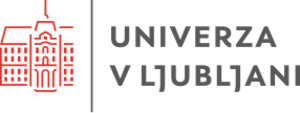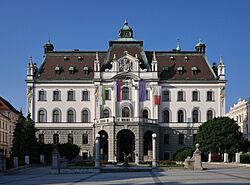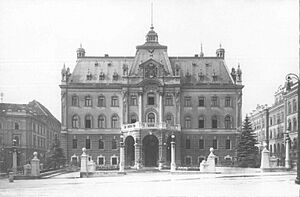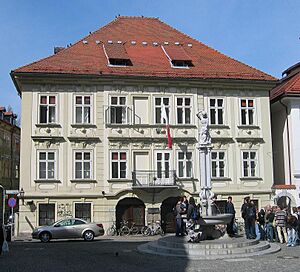University of Ljubljana facts for kids
|
Univerza v Ljubljani
|
|
 |
|
| Latin: Universitas Labacensis | |
| Type | Public |
|---|---|
| Established | 1919 |
| Rector | Gregor Majdič |
|
Administrative staff
|
cca 3,500 |
| Students | 37,615 |
| Location |
Ljubljana and Portorož
,
|
| Affiliations | Guild of European Research-Intensive Universities Utrecht Network UNICA |
| Website |
Building details
|

Main building of the University at 5 Congress Square, June 2015
|
|
| University rankings | |
|---|---|
| Global – Overall | |
| ARWU World | 601–700 (2023) |
| QS World | 621–630 (2024) |
| THE World | 801–1000 (2024) |
| USNWR Global | =450 (2023) |
| Regional – Overall | |
| QS Emerging Europe and Central Asia | 33 (2022) |
The University of Ljubljana (also called UL) is the oldest and largest university in Slovenia. It's a big school with about 38,000 students. The university has 23 different departments, called faculties, and three art schools. Around 4,000 teachers and researchers work there. They are helped by about 2,000 other staff members.
The University of Ljubljana offers many different study programs. You can learn about subjects like history and literature (humanities). You can also study science, technology, medicine, dentistry, and even how to care for animals (veterinary science).
The university was first built in the center of Ljubljana. The main building and most of its departments are still there. Over time, new buildings have been added in other parts of the city.
Contents
History of the University
Early Schools and Ideas
Even before the university, some special schools existed in Slovenia. These were set up by a group called the Jesuits in the 1600s. They taught subjects like philosophy and theology.
The very first university was started in 1810. This happened when France ruled the area. It was called the Écoles centrales. A person named Joseph Walland was in charge of this university. But in 1813, when Austria took control again, this university was closed. A different school, the Imperial Royal Lyceum, took its place.
The Dream of a Slovenian University
In the late 1800s, many people wanted a university where lessons were taught in the Slovene language. Many smart Slovene scholars worked in other countries. Also, many Slovene students went to universities in other parts of the Austro-Hungarian Empire. For example, some went to Charles University in Prague.
In the 1890s, a group was formed to help create a Slovenian university. Important leaders of this group included Ivan Hribar and Henrik Tuma. In 1898, the local government in Carniola (a region in Slovenia) offered money to students. This money was for those who planned to become university teachers. The idea was that they would teach at the new Ljubljana University once it opened. This helped create a list of future teachers.
However, political problems stopped the university from being built for a while. It finally became possible after the Austro-Hungarian Empire ended in 1918. Slovenia became part of a new country, the Kingdom of Yugoslavia.
On November 23, 1918, the first meeting to plan the university took place. Mihajlo Rostohar, a professor from Prague, led this meeting. He and Danilo Majaron convinced the government to pass a law. This law officially started the university. The law was passed on July 2, 1919. In August, the first professors were chosen. On September 18, these professors formed the University Council. This meant the university was ready to start. The first classes began on December 3 of that same year.
The First Years of Growth
In 1919, the university had five main departments. These were for law, philosophy, technology, theology, and medicine. The university's main building was in the central Congress Square of Ljubljana. This building used to be a government mansion. It was designed in 1902 and later changed by an architect named Josip Hudetz.
In the mid-1920s, the university was renamed. It became the "King Alexander University in Ljubljana." It kept growing, even with money problems. It also faced pressure from the government. In 1941, the National and University Library of Slovenia was finished. This was a big project for the university during those years.
During World War II, the university continued to operate. This was even though Italy and Nazi Germany occupied the area. There were many problems, and the university's freedom was limited. Some professors were arrested or sent to camps. Many students joined groups fighting against the occupation.
After 1945
After World War II ended, a Czech professor named Alois Král became the head of the university. He was the first and only foreigner to hold this position. After Yugoslavia became a Communist country in 1945, the university faced more political pressure. Many professors were fired, and some were arrested. The theology department was removed from the university. Some very smart students left the country.
However, the university continued to teach. It slowly gained back some freedom starting in the mid-1950s. But in the 1970s and early 1980s, some professors were again fired by the government. In 1979, the university was renamed "Edvard Kardelj University in Ljubljana." This was after a Communist leader. In 1990, when Yugoslavia broke apart, the university got its original name back.
University Structure
Departments and Art Schools
As of 2018, the University of Ljubljana has 23 departments (faculties) and three art schools. These are located all around the city of Ljubljana.
Here are some of them:
- Academy of Theatre, Radio, Film and Television
- Academy of Fine Arts and Design
- Academy of Music
- Faculty of Administration
- Faculty of Architecture
- Faculty of Arts
- Biotechnical Faculty
- Faculty of Chemistry and Chemical Technology
- Faculty of Civil Engineering and Geodesy
- Faculty of Computer and Information Science
- Faculty of Economics
- Faculty of Education
- Faculty of Electrical Engineering
- Faculty of Law
- Faculty of Maritime Studies and Transport
- Faculty of Mathematics and Physics
- Faculty of Mechanical Engineering
- Faculty of Medicine
- Faculty of Natural Sciences and Engineering
- Faculty of Pharmacy
- Faculty of Social Sciences
- Faculty of Social work
- Faculty of Sport
- Faculty of Theology
- Veterinary Faculty
- Faculty of Health Sciences
The university started in the center of Ljubljana. The main building and most departments are still there. Later, some new, modern buildings were built in other parts of the city.
University Libraries
The University of Ljubljana has two main university libraries. The National and University Library of Slovenia is the main library for the whole country. It also serves as the university's library. It has over 1.3 million books. It also has many other resources like pictures and videos.
Another important library is the Central Technological Library. This library is a national center for science and technology information. There are also more than 30 smaller libraries. These are located at different departments and institutes within the university. Some of the largest include the Central Humanist Library for arts and history. There is also the Central Economic Library for business and the Central Medical Library for health studies.
Art Gallery
The university also has its own art gallery. It opened on June 18, 2012.
Academics and Research
The University of Ljubljana does a lot of research. They study many different fields. These include science and the arts. They also research humanities (like history and languages), social sciences (like how people interact), and technology.
The University of Ljubljana was ranked among the top universities in the world. For example, in the QS World University Rankings 2023, it was ranked between 601st and 650th globally.
Famous People from the University
Many important people have studied or taught at the University of Ljubljana.
- Slavoj Žižek is a famous Slovenian philosopher and cultural critic. He studied at Ljubljana and earned a master's degree in philosophy in 1975. He is now a senior researcher at the university.
- Marko Bošnjak (judge) (born in 1974) is a Slovenian lawyer and judge. He is a judge at the European Court of Human Rights.
See also
 In Spanish: Universidad de Liubliana para niños
In Spanish: Universidad de Liubliana para niños
- List of modern universities in Europe (1801–1945)
- Slovenian Academy of Sciences and Arts
- Jožef Stefan Institute
- Ljubljana Student Organisation



